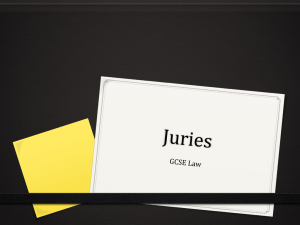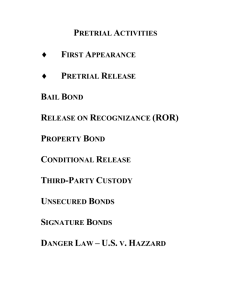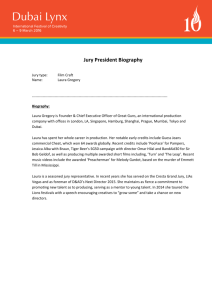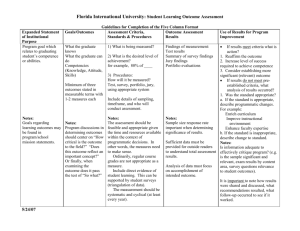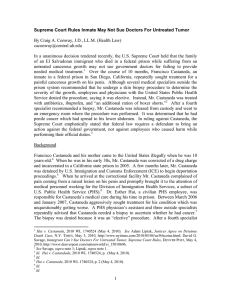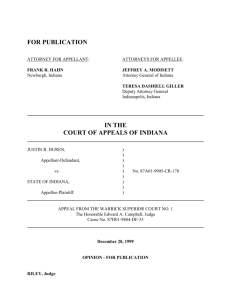j9-21
advertisement
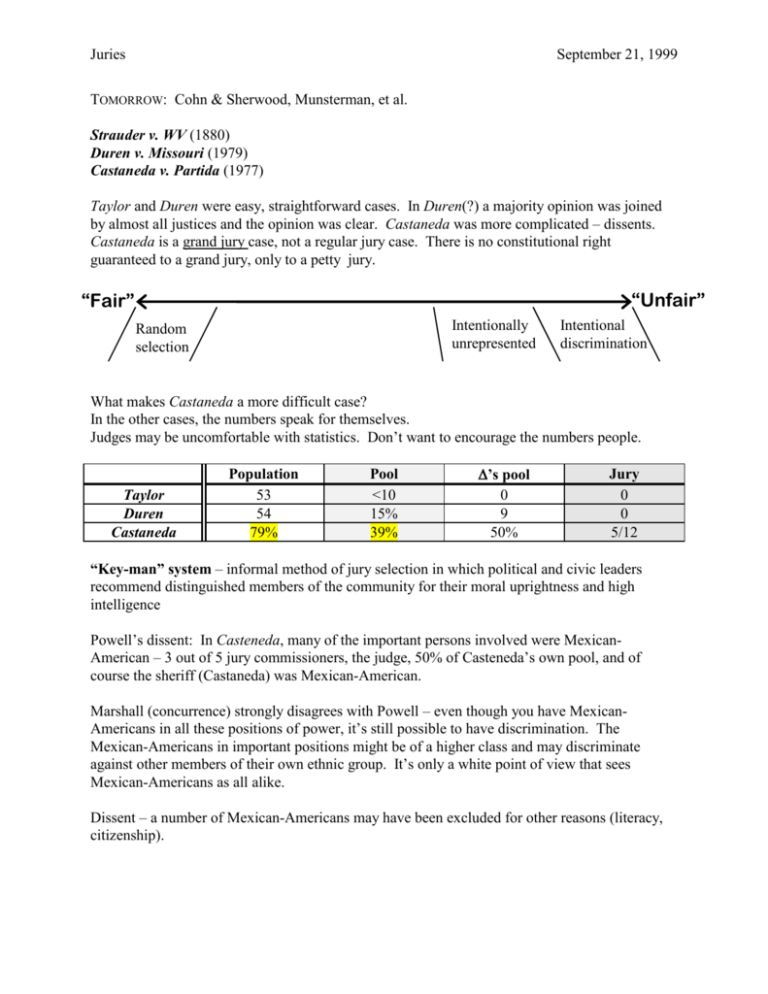
Juries September 21, 1999 TOMORROW: Cohn & Sherwood, Munsterman, et al. Strauder v. WV (1880) Duren v. Missouri (1979) Castaneda v. Partida (1977) Taylor and Duren were easy, straightforward cases. In Duren(?) a majority opinion was joined by almost all justices and the opinion was clear. Castaneda was more complicated – dissents. Castaneda is a grand jury case, not a regular jury case. There is no constitutional right guaranteed to a grand jury, only to a petty jury. “Unfair” “Fair” Intentionally unrepresented Random selection Intentional discrimination What makes Castaneda a more difficult case? In the other cases, the numbers speak for themselves. Judges may be uncomfortable with statistics. Don’t want to encourage the numbers people. Taylor Duren Castaneda Population 53 54 79% Pool <10 15% 39% ’s pool 0 9 50% Jury 0 0 5/12 “Key-man” system – informal method of jury selection in which political and civic leaders recommend distinguished members of the community for their moral uprightness and high intelligence Powell’s dissent: In Casteneda, many of the important persons involved were MexicanAmerican – 3 out of 5 jury commissioners, the judge, 50% of Casteneda’s own pool, and of course the sheriff (Castaneda) was Mexican-American. Marshall (concurrence) strongly disagrees with Powell – even though you have MexicanAmericans in all these positions of power, it’s still possible to have discrimination. The Mexican-Americans in important positions might be of a higher class and may discriminate against other members of their own ethnic group. It’s only a white point of view that sees Mexican-Americans as all alike. Dissent – a number of Mexican-Americans may have been excluded for other reasons (literacy, citizenship). Juries September 21, 1999 Do members of an ethnic group all have a core experience in common that no other ethnic groups have? EMoutz: This is a bad path to tread. Venire percentages ought to be kept close to population percentages for the sake of public legitimacy only. Beyond that it is dangerous to assume that people within the same ethnic groups have similar personality traits. What constitutes a critical mass of people in a jury pool? When figuring out a critical mass for women, should we take into account the empirical fact that women talk less on juries? What can be done to ensure that everyone gets jury service? Judge Cohn tried a system… tomorrow. Juries September 21, 1999 From my criminal procedure notes: D. Constitution Limits on Jury Selection 1. Selecting the venire a. The (6th Amendment) Cross-Section Guarantee Taylor v. Louisiana (1975, p. 1400) “But the jury wheels, pools of names, panels or venires from which juries are drawn must not systematically exclude distinctive groups in the community and thereby fail to be reasonably representative thereof.” Duren v. Missouri (1979, p. 1403) Based on fact that women could easily opt out of jury service and a very small percentage of women served on juries, court held that had made out “a prima facie fair-cross-section violation” by showing that 1. The group alleged to be excluded is a distinctive group in the community 2. The representation of this group in venires from which juries are selected is not fair and reasonable in relation to the number of such persons in the community 3. This under-representation is due to systematic exclusion of the group in the jury selection process 4. State had not carried its burden of justifying this infringement by showing attainment of a fair cross section to be incompatible with a significant state interest. b. Equal Protection Fourteenth Amendment equal protection challenges to state jury selection procedures prevailed long before the Sixth Amendment right to jury trial was applied to the states. The defendant in an equal protection claim has to show there was an intent to discriminate – this wasn’t required for a 6th amendment claim. Must show the defendant was a member of an excluded class. Substantial under-representation. Show there was an opportunity to discriminate. This is just a prima facie case. If the state can show a good reason, there’s no equal protection violation. Racial discrimination – equal protection cases: Strauder v. West Virginia (1880, p. 1404) It is a denial of equal protection to try a defendant before a jury where all members of his race have been excluded by statute. (state action presumed constitutional, burden on ) Castaneda v. Partida (1977, p. 1405) County was 79.1% Mexican-American, but over 11 years, only 39% of persons summoned for grand jury service were Mexican-American. This fact established a prima facie case of discrimination which was unrebutted absent evidence that racially neutral qualifications for grand jurors resulted in the lower proportion of Mexican-Americans.


